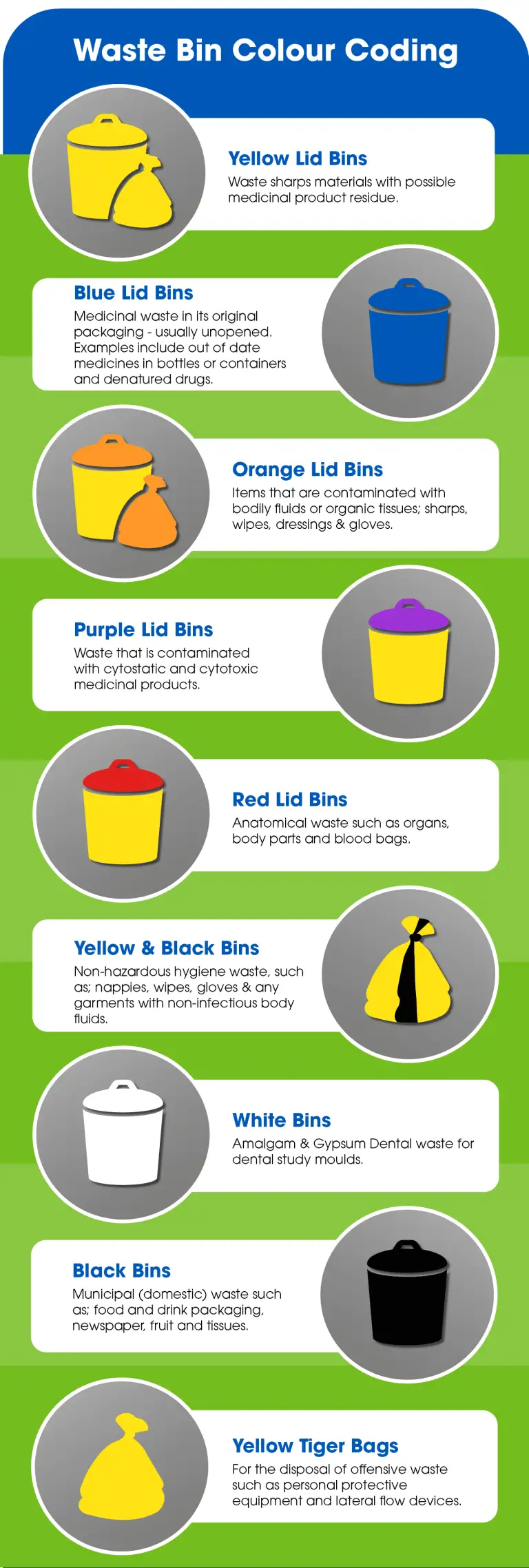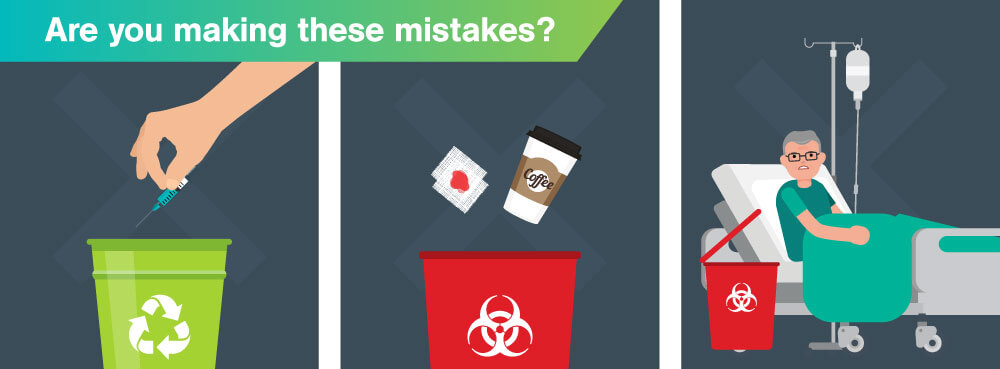Conformity and Laws for Medical Waste Disposal
Conformity and laws for clinical waste disposal play an essential role in making certain the safety and security and wellness of both health care experts and the general public. Correct monitoring of clinical waste is necessary to avoid the spread of infections, secure the atmosphere, and preserve public health and wellness. These laws incorporate numerous aspects, including the classification and partition of medical waste, proper storage space and dealing with procedures, as well as transport and disposal techniques.
Importance of Compliance
The value of conformity with guidelines for medical garbage disposal can not be overstated. Correct disposal of clinical waste is essential for guaranteeing the security and health of healthcare workers, people, and the public. Medical waste, that includes products such as used needles, infected handwear covers, and biomedical waste, can posture major health and wellness threats otherwise handled and thrown away properly.
Compliance with policies makes sure that medical waste is managed in such a way that reduces the capacity for direct exposure to harmful compounds and transmittable conditions - medical waste disposal service. It assists protect against the spread of infections, such as HIV, liver disease B and C, and various other bloodborne pathogens. Conformity additionally plays an essential duty in securing the environment by stopping contamination of water resources, dirt, and air
Failing to follow regulations can cause extreme repercussions for healthcare facilities, consisting of penalties, lawful action, and damages to their track record. Additionally, non-compliance may jeopardize the health and wellness of health care workers, patients, and the neighborhood.
Conformity with policies for medical waste disposal calls for adherence to certain standards and procedures. These may include appropriate partition, packaging, labeling, and storage space of clinical waste. It also involves using authorized disposal methods, such as incineration, landfilling, or autoclaving, relying on the kind of waste.
Regulative Agencies and Bodies
Regulatory agencies and bodies play an important function in looking after conformity with policies for clinical garbage disposal. These organizations are in charge of setting standards, protocols, and standards to ensure the proper and risk-free handling of medical waste. They keep an eye on and enforce compliance to secure public health and the setting.
Among the most popular regulative companies in the United States is the Environmental Protection Agency (EPA) The EPA is in charge of managing the storage, transportation, therapy, and disposal of medical waste. They establish guidelines for waste generators, transporters, and therapy centers to follow, ensuring that all essential safety measures are required to stop the spread of illness and contamination.
An additional vital governing body is the Occupational Safety And Security and Health Administration (OSHA) OSHA sets requirements and laws to safeguard employees from job-related dangers, consisting of those pertaining to medical waste. WasteX Medical Waste Disposal. They give guidelines for the risk-free handling and disposal of clinical waste to secure staff members in health care centers
In addition to these federal firms, specific states additionally have their own regulative bodies that supervise medical waste disposal. These agencies might have their very own specific laws and demands that should be complied with.

Classification and Segregation of Medical Waste
To make sure correct management of medical waste, it is necessary to identify and segregate it according to developed methods and standards. medical waste disposal service. Category and segregation play an essential function in reducing the risk of infection, safeguarding the atmosphere, and making sure the safety and security of health care workers and the public
Medical waste is categorized into various groups based on its prospective danger level. These classifications include infectious waste, pathological waste, sharps waste, pharmaceutical waste, chemical waste, and contaminated waste. Each classification calls for particular handling, storage space, transportation, and disposal techniques to decrease the threat of exposure and contamination.
Segregation of clinical waste entails separating various sorts of waste at the source. This procedure makes certain that waste with various threat levels is not combined, minimizing the capacity for cross-contamination and making disposal procedures a lot more effective. Proper partition is attained through the use of color-coded containers and tags, which help healthcare employees and waste management workers take care of each type and identify of waste properly.
In addition to classification and segregation, medical care facilities should likewise comply with regional, state, and government regulations concerning medical waste administration. These policies lay out certain needs for storage, transport, therapy, and final disposal of medical waste, guaranteeing compliance and keeping public wellness and security.
Appropriate Storage Space and Managing Procedures
Appropriate storage space and handling treatments play an essential duty in making sure the risk-free and certified management of medical waste. Medical waste, which includes items such as utilized syringes, contaminated gloves, and ran out medicines, can pose severe wellness and environmental dangers otherwise dealt with appropriately. It is important for health care facilities and other generators of medical waste to apply stringent storage and dealing with procedures.
To start with, clinical waste must be kept in long lasting, watertight containers that are especially created for this objective. These containers need to be classified with the global biohazard symbol and words "clinical waste" to clearly show the contents. In addition, the containers should be maintained safely shut to avoid any type of potential leak or spillage.
Furthermore, it is essential to segregate various kinds of clinical waste to protect against cross-contamination. Sharps, such as scalpels and needles, must be stored in puncture-resistant containers to lessen the risk of injuries - WasteX Medical Waste Disposal. Chemical waste, such as solvents and anti-bacterials, must be stored individually from other sorts of clinical waste to stop chemical responses or hazardous direct exposures

Transport and Disposal Techniques
Health care facilities must make certain the safe transportation and appropriate disposal of their medical waste to follow laws and protect public health and wellness. Transport and disposal approaches play an important function in protecting against the spread of infectious diseases and lessening the environmental impact of medical waste.
To transfer medical waste, health care centers need to use watertight and puncture-resistant containers that are labeled with the biohazard symbol. These containers should be firmly sealed to avoid any leakage throughout transportation. Furthermore, healthcare facilities must develop procedures for the transportation procedure, consisting of using committed automobiles and qualified workers.
When the clinical waste gets to the disposal facility, it undergoes different methods of treatment. One usual technique is incineration, which entails shedding the waste at high temperatures to ruin virus and lower the quantity of waste. One more approach is autoclaving, which makes use of heavy steam and stress to sanitize the waste. After treatment, the waste is normally sent out to a garbage dump or a waste-to-energy facility for last disposal.
It is important for healthcare facilities to work with certified and permitted waste monitoring companies to make sure proper transportation and disposal of medical waste. These firms have the experience and sources to handle clinical waste securely and in compliance with regulations.
Conclusion
In final thought, conformity with policies for clinical waste disposal is of utmost significance to guarantee public health and safety and security. On the whole, adherence to compliance and laws is needed to properly handle clinical waste.
Medical waste, which consists of items such as used needles, infected gloves, and biomedical waste, can posture major health and wellness threats if not managed and disposed of correctly.
These categories consist of contagious waste, pathological waste, sharps waste, pharmaceutical waste, chemical waste, and radioactive waste.Segregation of clinical waste includes dividing various types of waste at these details the source. Appropriate partition is achieved via the usage of color-coded tags and containers, which aid health care workers and waste monitoring personnel determine and handle each type of waste appropriately.
Chemical waste, such as solvents and disinfectants, need to be stored separately from various other kinds of medical waste to stop dangerous exposures or chemical responses.